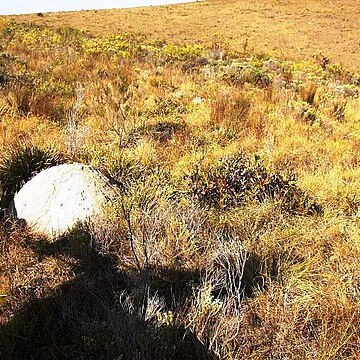Shrub, lignotuberous, with many, erect stems, 0.7-1.5 m high. Leaves petiolate, lanceolate to elliptic, narrowing towards petiole, 90-160 x 15-70 mm, slightly granulate, coriaceous, hairless when mature, margins wavy. Flower head ovoid to globose, cyathiform, 30-40 mm in diam., hidden by large overtopping leaves. Involucral bracts 4-or 5-seriate; outer series ovate, obtuse, 7-15 x 7-12 mm, green-yellow, flushed carmine, fine hairs on outer surface; inner series oblong-spathulate, obtuse, 30-35 x 10 mm. Flowers white, 25-30 mm long, straight, tube 8-10 mm long, glabrous, tips with white or brown woolly hairs; style 25 mm long, straight or curved, carmine; pollen presenter 5 mm long, linear. Flowering time May, June.
Rounded, resprouting shrub to 1.5 m. Leaves elliptic-oblanceolate, glabrescent. Flower heads subglobose, concealed by upper leaves, often clustered, 30-40 mm diam., involucral bracts greenish cream, sometimes flushed pink, style ± 25 mm long.


